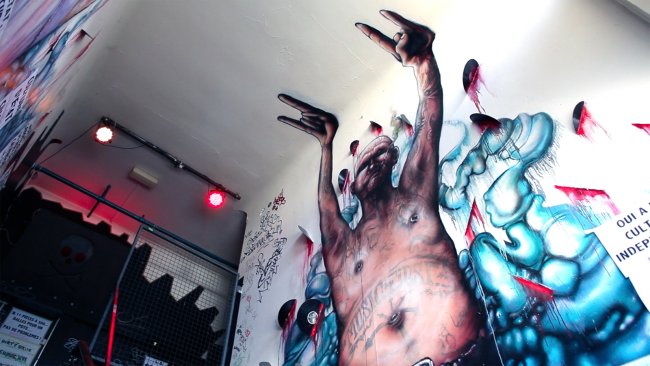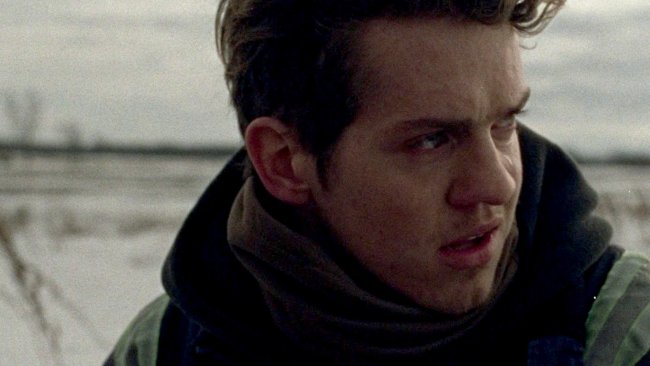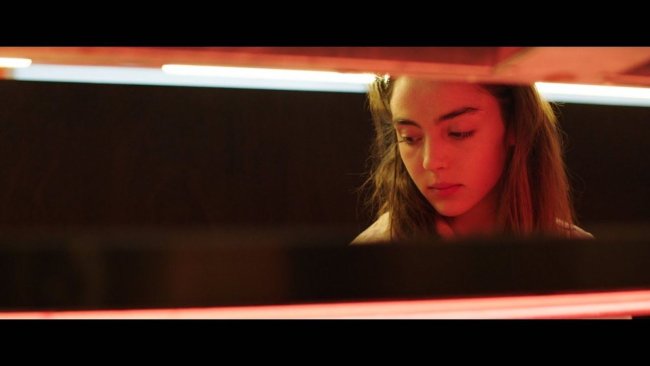Diego Marcon | Have You Checked the Children?
[…] Marcon’s works are icebergs, emerging pieces of cinema (and of cinematic theatre), whose intensity depends on the submerged and metaphysical abyss that we can experience through them. Marcon’s iceberg are children that, if properly checked, will reveal their non-innocent, submarine faces.
Text: Giuseppe Di Salvatore
Cinematic icebergs
Wham! The flesh-and-show photograms that give rhythm to Diego Marcon’s Monelle (2017) coincide with shocking detonations. They are so well distributed in time that we cannot but be trapped in the attraction-fear dynamic. The room is completely dark, making of this work a perfectly cinematic piece recalling Hitchcockian suspense and, more precisely, the infamous Rear Window scene of Jeffrey flashing the approaching murder. This cinematic thread is my interpretation key to disclosing Marcon’s wonderful exhibition at the Kunsthalle Basel.
Monelle is not only playing with the black box dispositive but also with the blackness of the screen as an essential ingredient to making visibility visible. We see the photogram, the backbone of any form of cinematics, yet our vision is constrained to a liminal comprehension of what is seen: girls lying or posing or something-doing within a muscular architecture (Como’s Casa del fascio). Cinematic vision is up to us, to our imagination, working at the detonating borders of visibility. Simultaneously, the loud bangs of the (cinema) shooting seem to coordinate with another work nearby, one both inside and outside the black box of Monelle: that’s Untitled (Head Falling) (2015), where the movement of a head fighting against falling asleep – and repeatedly awoken by the bangs? – is barely perceptible; the few images per seconds of the animated videos place us into this liminal domain of perception where the vision of singular images and the vision of movement coexist. Again, we experience the limits between photography and cinema, or how cinema emerges from the stillness of the image, from blackness, from silence.
The series of Untitled (Head Falling) connects three rooms of the Kunsthalle and leads us from the black box of Monelle to a sort of theatre foyer, where a marching band of children silently parades (La banda di Crugnola, 2023). They are frozen in concrete sculptures, the musical instruments not being played: a statuary, sinister innocence is staged within the welcoming red of velvet carpets on the walls. Like the girls frozen in Fascist architecture, Marcon continues to display sharp contrasts with minimalist and highly effective artistic choices. The deep silence of concrete in La banda di Crugnola is like a cold shadow on warm skin. More generally, I would say that the stillness, the blackness, and the silence are the sea from which Marcon’s works emerge, like the tips of icebergs. These “tips” are simple materials and forms – generously and skilfully placed in dialogue with the space of the exhibition – as his works appear immediate, straightforward, compelling. However, they conceal a surprising inner complexity, and provide a deep experience for us.
The image of the iceberg perfectly suits the two films that open and close the linear path of the Kunsthalle exhibition. Both of them use the codes of familiarity – even literally, through quiet, home-feeling sets – in order to guide us towards the most disquieting situations. The overt lyrism of The Parent’s Room, where a musical-like song emerges from a long moment of silence, places itself in the middle of a dreadful crime scene. An unsettling empathy for the murderer evolves into a metaphysical journey beyond sorrow and death, thanks also to a specific aesthetic - a sort of clinical realism powered by digital animation - and the recalling of the atmospheres of Roy Andersson’s cinema. This is a still life cinema, a still life imaginary that becomes animated, where digital birds appears like an epiphany, while the living mask of death is singing. The same mixture of realism and digital animation marks the aesthetic of Dolle (2023): we seem to be immersed into a children-like puppet movie with a family of cute moles engaged in the protection of their mole-hole-home; while the children sleep, the parents tirelessly and carefully count together between bed and rocking chair. «Cinque – cinque – più – più – diciannove – diciannove – più – più – quattordici – quattordici – più – più…». Through the hypnotic lullaby of numbers, the harmony of the atmosphere slowly grows disquieting, as we realise that they are eyeless, their additions thereby becoming a completely absurd activity, a sort of manic attempt to hold on to an (impossible) order under the constant threat of noisy earthquakes from the outer world. The line of numbers reveals a delusive value for holding the world together, making it meaningful: its fragility ejects the poor and charming moles into a cosmic emptiness.
Akin to The Parent’s Room, Dolle starts from the familiar world with its children and innocence (Have You Checked the Children?) – the tip of the iceberg – in order to venture into the metaphysical space of death and existential insecurity – under the sea – which is a typical pattern of horror movies. Dolle is screened in a kind of cinema theatre with a terraced mini-auditorium, enhancing the immersive experience for the viewer. However, the film makes use of the familiar-uncanny contrast and, together with all the other exhibited works, confirms the “emersive” methodology of bringing the immersive experience of cinema to its back grammar, to the fundamental elements of stillness, blackness and silence from which cinema can emerge as such. Therefore, the metaphysical direction toward which the two films orientate us – the bottom of the submerged part of the iceberg – joins forces with the experience of the formal elements of cinema – the sea. In this sense, Marcon’s works are icebergs, emerging pieces of cinema (and of cinematic theatre), whose intensity depends on the submerged and metaphysical abyss that we can experience through them. Marcon’s iceberg are children that, if properly checked, will reveal their non-innocent, submarine faces.
Would you like to cling to the tip of the iceberg? Just continue to count, if you can, again and again: cinque – cinque – più – più – diciannove – diciannove – più – più – quattordici – quattordici – più – più…







